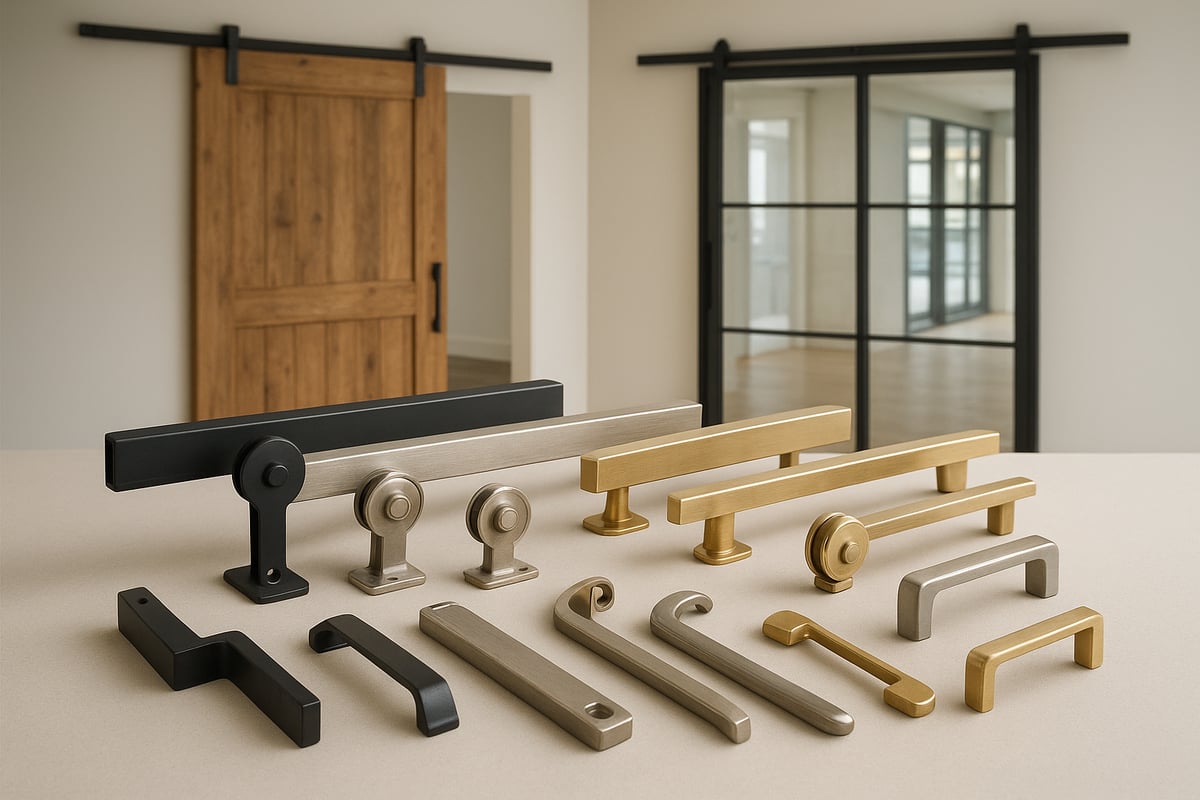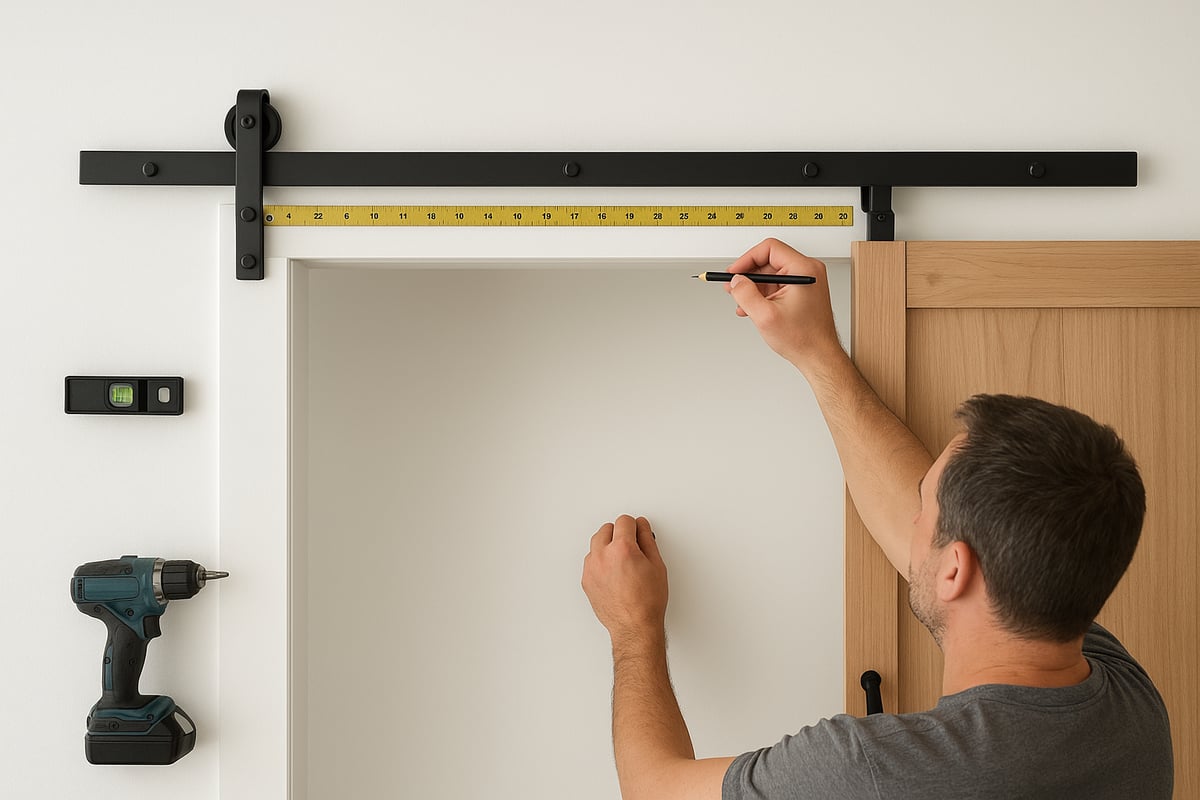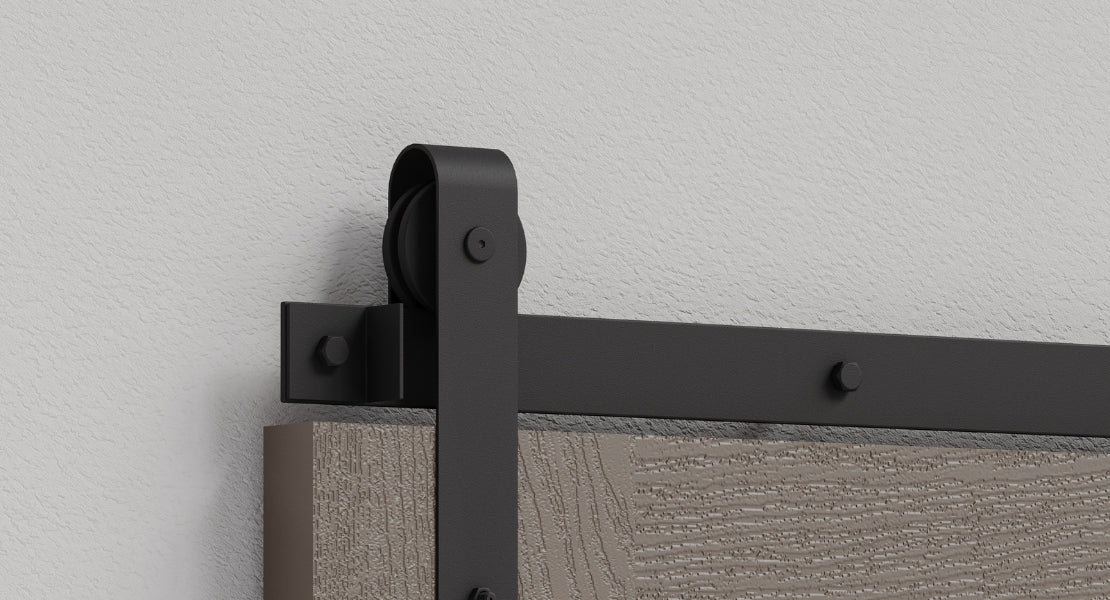
Door Hardware for Sliding Doors: The Essential Guide 2025
Sliding doors are taking the spotlight in both homes and commercial spaces, thanks to their space-saving design and stylish versatility. Whether you are renovating or building new, the right door hardware for sliding doors can make all the difference in both form and function.
This essential guide walks you through everything you need to know for 2025, from understanding the different types of sliding door hardware to choosing the perfect match for your needs. You will also learn about installation tips, easy maintenance routines, and the latest trends shaping the future of sliding doors.
Curious about how to make your doors glide seamlessly and look stunning? Dive in and discover how to transform any space with the right hardware choices—your next project starts here.
Understanding Sliding Door Hardware: Types and Functions
Sliding doors are everywhere these days, right? Whether you’re eyeing a trendy barn door for your living room or a sleek glass setup for your office, understanding the ins and outs of door hardware for sliding doors is the first step to a smooth installation. Let’s break down the main types, essential hardware pieces, and what makes each option shine in real-life spaces.

Overview of Sliding Door Systems
You’ve probably seen barn doors trending on social media, but sliding door systems don’t stop there. There’s a whole family of styles, each with its own hardware needs. Barn doors use exposed tracks and are perfect for spaces where you want a statement piece. Pocket doors slide right into the wall, saving space and creating a seamless look. Bypass doors let multiple panels glide past each other, making them great for closets or large openings. Bi-fold sliding doors fold in sections, ideal for maximizing wide passageways.
Each system requires specific door hardware for sliding doors. Barn doors need robust, visible tracks, while pocket doors require hidden, in-wall components. Bypass and bi-fold systems have specialized rails and guides to handle multiple panels. In homes, these doors are popular for bedrooms, bathrooms, and closets. Commercially, you’ll find them in conference rooms and offices where flexible space matters.
Core Hardware Components Explained
Now, let’s dive into what makes these doors glide so effortlessly. The backbone of any door hardware for sliding doors includes:
- Tracks and Rails: These can be wall-mounted for barn doors or ceiling-mounted for a minimalist look.
- Rollers and Hangers: Made from steel or nylon, they support the door’s weight and ensure a quiet, smooth slide.
- Door Guides: These keep the door stable, preventing swaying. You’ll find both floor and wall guide options.
- Handles, Pulls, and Locks: Style meets function, whether you want a modern pull or a secure lock.
If you’re exploring options, check out the variety of sliding door hardware kits available, which bundle these components for easy selection.
Choosing the right combination ensures your door operates flawlessly and matches your space’s needs.
Specialized Hardware Options
There’s more to door hardware for sliding doors than just the basics. Today, you’ll find soft-close and auto-close systems that gently pull your door shut, adding a touch of luxury and preventing slamming. For heavier doors or commercial spaces, heavy-duty and commercial-grade tracks and rollers are a must, supporting higher weight and frequent use.
Minimalist and hidden hardware is on the rise, especially for modern interiors. Concealed tracks and flush-mount handles create a clean, uncluttered look. These specialized options let you customize your door’s performance and appearance, blending seamlessly into any design vision.
Materials and Finishes: Style Meets Durability
The material and finish of your door hardware for sliding doors isn’t just about looks—it’s about longevity too. Common materials include:
| Material | Finish Options | Durability |
|---|---|---|
| Solid Steel | Matte Black, Rustic | High |
| Stainless Steel | Brushed Nickel | Superior |
| Aluminum | Polished, Anodized | Moderate |
Matte black and brushed nickel are trending for 2025, fitting both modern and industrial styles. Brass and rustic textures add warmth to traditional spaces. Choosing the right material means your hardware will resist wear, corrosion, and scratches over time, keeping your doors looking and working great.
Real-World Examples
Let’s bring it all together. In a modern loft, a concealed track system allows a glass door to float along the wall, creating an open, airy vibe. Contrast that with a rustic farmhouse, where classic barn door hardware in aged steel adds authentic charm to a reclaimed wood door.
Did you know that over 60% of new home renovations in 2024 included sliding door installations? This surge shows how door hardware for sliding doors is shaping both function and style in today’s homes and businesses.
Key Factors to Consider When Choosing Sliding Door Hardware
Choosing the right door hardware for sliding doors can feel overwhelming with so many options out there. Each space, whether at home or in a business, has unique needs. Let’s break down the most important factors so you can make a confident, informed decision.

Door Weight, Size, and Application
First, think about the weight and size of your door. Not all door hardware for sliding doors is created equal. For a heavy solid wood or glass panel, you’ll need hardware with a high weight rating. Lighter doors may work with more economical kits.
Measure your door’s height, width, and thickness. Are you using a standard size, or is this a custom piece? Commercial spaces and industrial settings often call for heavy-duty systems, while residential projects may need something more streamlined.
When matching door hardware for sliding doors to your project, always check the manufacturer’s weight limits. Oversized or extra tall doors might require custom solutions, so don’t be afraid to ask a pro if you’re unsure.
Space Constraints and Wall Structure
Ever wondered if you have enough space for a sliding door? It’s a common concern. For starters, you’ll need clear wall or ceiling space that’s at least twice as wide as your door panel. This ensures the door can fully open.
Check for obstacles like light switches, outlets, or decorative trim. These can interfere with your track installation. If you’re dealing with a heavy door, make sure your wall studs or ceiling joists are reinforced and can handle the load of your chosen door hardware for sliding doors.
If space is tight, consider pocket doors or bypass systems. They’re great for maximizing small rooms or hallways, giving you flexibility without compromising design.
Style, Finish, and Interior Design Compatibility
You want your door hardware for sliding doors to look as good as it functions. Start by matching the finish to your room’s décor. Matte black is trending for 2025, offering a sleek, modern vibe. Industrial spaces often feature brushed nickel or mixed-metal finishes.
Working with a designer? They might suggest bold pulls, rustic handles, or even minimalist flush pulls for tight spaces. For inspiration, check out this handles and flush pulls selection to see what’s possible.
Remember, your hardware is a focal point. Choose pieces that complement your style, from classic barn door looks to ultra-modern concealed systems.
Security and Privacy Features
Privacy matters, especially for bedrooms, bathrooms, or offices. When picking door hardware for sliding doors, look for secure locking mechanisms that suit your needs. Options range from simple privacy latches to keyed locks for extra security.
If you have kids or pets, consider hardware with built-in child safety features. Some products are rated for higher security, so compare ratings if privacy is a top priority.
Don’t overlook the ease of use—locks and latches should be intuitive and comfortable, not cumbersome.
Ease of Installation and Maintenance
How handy are you with tools? Some door hardware for sliding doors comes pre-assembled, making installation easier for DIYers. Others require more advanced skills and tools, so check what’s included before you buy.
Think about future maintenance, too. Rollers may need occasional lubrication, and fasteners should be checked and tightened now and then. Clean tracks and guides regularly to keep things running smoothly.
If you prefer less hassle, choose hardware with fewer moving parts or consider hiring a professional for installation.
Budget and Warranty Considerations
Let’s talk numbers. Door hardware for sliding doors ranges from budget-friendly kits to premium designer sets. Prices typically start around $50 for basic hardware and can exceed $500 for high-end systems or custom finishes.
Check the warranty—longer coverage means better peace of mind. Look for brands that offer solid customer support and easy-to-understand return policies.
Here’s a quick comparison:
| Hardware Type | Average Cost (2025) | Typical Warranty |
|---|---|---|
| Standard Kit | $50–$150 | 1–3 years |
| Premium Kit | $200–$500+ | 5+ years |
Before you decide, weigh the upfront cost against long-term value and support. Sometimes, spending a bit more upfront saves you money and headaches down the road.
Step-by-Step Guide: Installing Sliding Door Hardware
Installing door hardware for sliding doors can feel like a big project, but with the right approach, you can achieve a smooth, professional result. Let’s walk through each step so you can avoid headaches and enjoy seamless sliding for years to come.

Preparation and Planning
Before you even touch your drill, preparation is key. Start by measuring your doorway’s width and height. Add at least twice the door width for your track length to ensure the door fully clears the opening.
Check your wall for studs or solid support where the track will mount. Use a level to mark precise mounting points. Gather all the tools you’ll need: a drill, level, tape measure, pencil, stud finder, and safety gear.
Now is the perfect time to review the Installation manual and guides for your specific door hardware for sliding doors. Reading these instructions before you start can help you avoid surprises and streamline your workflow.
Installing the Track and Mounting Hardware
With your marks in place, it’s time to install the track. Secure the track to your wall or ceiling, making sure you anchor it into studs or use appropriate wall anchors for extra stability.
Double-check the track’s alignment with your level. A crooked track can cause your door to slide unevenly or even come off the rails. Tighten all fasteners but don’t overtighten, as this can damage the hardware.
Common mistakes? Skipping the level check or missing a stud—both can lead to headaches down the road. Remember, a sturdy and level track is the backbone of reliable door hardware for sliding doors.
Attaching Rollers, Hangers, and Door Guides
Next, attach the rollers or hangers to the top of your door. Follow the manufacturer’s template or measurements for accurate placement.
Don’t forget the door guide. Depending on your setup, you’ll use either a floor-mounted or wall-mounted guide to keep the door from swinging. Carefully secure it so the door glides smoothly and stays stable during operation.
Choosing the right guide is crucial for door hardware for sliding doors, as it prevents wobble and ensures a straight path every time you open or close your door.
Hanging the Door and Testing Movement
Ready for the most rewarding part? Carefully lift the door and place the rollers onto the track. This step is easier with a friend, especially if your door is heavy.
Once the door is hanging, slide it back and forth. Check for smooth movement, clearance from the floor, and proper alignment with the wall. If the door sticks or wobbles, adjust the rollers or guides until you’re satisfied.
Troubleshooting is part of installing door hardware for sliding doors—small tweaks here will pay off in flawless operation later.
Adding Handles, Pulls, and Locks
Now it’s time to add personality and function. Choose handles or pulls that match your style and offer comfortable grip. For tight spaces, flush pulls are a great solution.
Mark handle positions using a template or painter’s tape, then drill pilot holes before attaching. If privacy or security is needed, integrate locks or latches according to the door’s use.
Handles and locks are more than decoration—they’re critical components of door hardware for sliding doors, ensuring both ease of use and peace of mind.
Final Adjustments and Safety Checks
Almost there! Tighten all screws and fasteners one more time. Test the door’s movement and make sure the lock engages smoothly.
Check for any pinch points or exposed screws that could pose a hazard to children or pets. A quick safety sweep now can prevent accidents later.
Reliable door hardware for sliding doors should feel secure and operate effortlessly. Taking time for these last checks makes all the difference.
Pro Tips for a Professional Finish
Want your installation to look truly polished? Use a template for perfectly aligned handles and pulls. Conceal screws with matching caps or touch-up paint for a seamless appearance.
If you’re new to installing door hardware for sliding doors, start with a pre-assembled kit and follow instructions closely. Don’t rush—measure twice and drill once.
Here’s a quick checklist for a pro finish:
- Double-check all measurements
- Conceal mounting hardware
- Lubricate moving parts for smooth sliding
With these tips, your sliding door will look and perform like a custom feature.
Maintenance and Troubleshooting for Sliding Door Hardware
Keeping your door hardware for sliding doors in top shape is easier than you might think. Regular attention helps prevent squeaks, sticking, and the dreaded off-track door. Let’s walk through the essential steps for routine care, troubleshooting, and knowing when it’s time for an upgrade.

Routine Cleaning and Lubrication
To ensure smooth operation, regularly clean your door hardware for sliding doors. Dust and debris can quickly build up in tracks and on rollers, causing friction or even damage. Use a soft brush or vacuum to remove dirt, then wipe down with a damp cloth.
Apply a silicone-based lubricant to the track and rollers every few months, especially in high-traffic areas. Avoid oil-based products, as they attract more dirt. Schedule a quick check every season, and your sliding doors will glide effortlessly all year.
Diagnosing Common Issues
When your door hardware for sliding doors makes noise or feels stiff, it’s time for a closer look. Listen for squeaks, which usually mean the rollers need lubrication or cleaning. If the door slides unevenly, check for misalignment or obstructions in the track.
Loose handles or wobbly hardware often result from regular use. Tighten screws and inspect for wear. If your door feels unstable, inspect the guides. For more on this, see these floor guides for sliding doors to ensure proper support and stability.
Extending Hardware Lifespan
Protecting your door hardware for sliding doors from scratches and corrosion helps extend its life. Choose gentle cleaning products to avoid damaging finishes like matte black or brushed nickel. Wipe away water or spills promptly to prevent rust, especially on steel components.
Consider upgrading rollers or guides if you notice early signs of wear. Some manufacturers offer enhanced components built for durability. Always follow the care instructions provided with your hardware for best results.
When to Replace or Upgrade Hardware
Wondering if your door hardware for sliding doors needs replacing? Look for bent tracks, worn-out rollers, or damaged guides—these are clear signs it’s time for action. Upgrading to soft-close or heavy-duty systems can improve performance and reduce maintenance needs.
Here’s a quick comparison to help you decide:
| Issue | Repair | Replace/Upgrade |
|---|---|---|
| Minor squeaks | ✔️ | |
| Bent track | ✔️ | |
| Worn rollers | ✔️ | ✔️ |
| Outdated style | ✔️ |
Sometimes, investing in new hardware is more cost-effective than repeated repairs.
Expert Support and Warranty Claims
If you run into persistent problems with your door hardware for sliding doors, don’t hesitate to reach out for expert help. Most reputable brands and retailers offer customer support and troubleshooting guides. Keep your purchase receipts and warranty information handy, as this speeds up claims for defective or damaged parts.
When contacting support, provide clear details and photos if possible. This helps ensure a quick resolution and keeps your sliding doors operating at their best.
Top Sliding Door Hardware Trends for 2025
Have you noticed how door hardware for sliding doors is popping up everywhere lately? In 2025, the world of sliding door hardware is evolving at lightning speed. Homeowners and designers are embracing features that blend tech, sustainability, and personal style. Let’s explore what’s hot this year and how you can make your space stand out with the latest trends in door hardware for sliding doors.
Smart and Automated Sliding Door Hardware
Imagine opening your sliding door with just a tap on your phone or a wave of your hand. In 2025, smart door hardware for sliding doors is quickly becoming a must-have. These systems now integrate seamlessly with popular smart home platforms, letting you control access, monitor entry, and even schedule door operations remotely.
Motion sensors and app-based controls are making life easier, especially for busy families and commercial spaces. The market for smart sliding door hardware is projected to grow by over 20% this year. If you want to see how these systems install in real life, check out this Sliding Door Installation Guide for step-by-step details.
Sustainable and Eco-Friendly Materials
Sustainability is no longer just a buzzword. Many brands are now offering door hardware for sliding doors made from recycled metals or manufactured with low-impact processes. Look for eco-labels and certifications when shopping for new hardware.
Popular choices include stainless steel with recycled content and aluminum that’s been reclaimed from other uses. Not only do these materials help reduce your carbon footprint, but they also offer impressive durability. Leading brands are setting the pace by combining eco-friendly practices with cutting-edge design.
Minimalist and Concealed Hardware Designs
Do you crave a sleek, clutter-free look? Minimalist door hardware for sliding doors is dominating modern homes and offices. Hidden tracks, flush-mounted handles, and unobtrusive guides create an uninterrupted flow between rooms.
This trend fits perfectly with open-plan layouts and contemporary aesthetics. Designers are drawing inspiration from upscale residential and commercial projects, where less is definitely more. If you’re curious about the installation process for these streamlined styles, you might find the How to Hang a Sliding Door guide helpful.
Customization and Personalization Options
Everyone wants their space to reflect their personality, right? In 2025, customization takes center stage for door hardware for sliding doors. Think custom finishes, engraved handles, and modular components that adapt to your needs.
You can now choose from matte black, brushed brass, or even mixed-metal looks to match your décor. Surveys show that 70% of buyers prefer hardware that can be tailored to their style. Flexible layouts and unique handle designs ensure there’s something for every taste and space.
So after diving into all the essentials for choosing and installing sliding door hardware, you might be wondering where to actually find the right pieces to bring your ideas to life. That’s where it gets exciting—because you don’t have to settle for just anything off the shelf. Whether you’ve got your eye on a modern look or want something more rustic, you deserve hardware that’s as reliable as it is stylish. If you’re ready to explore top-notch options (and maybe even get a little expert support along the way), check out the collection at barn door hardware. It’s a great next step for making your project a reality.


